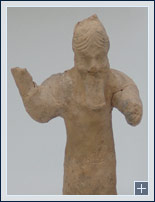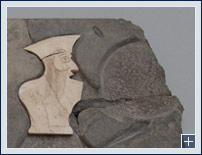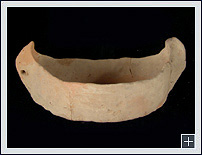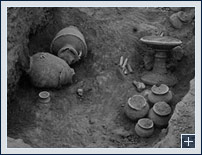Ancient Mesopotamian History
 [/kish/fieldmus/images/MES1-large.jpg]
[/kish/fieldmus/images/MES1-large.jpg]
When discovered, this figurine was wearing a copper girdle and band over his right shoulder and held a copper staff in his left hand and brandished a copper weapon in his right. The deity represented may combine aspects of a warrior god and the minister of the gods, Ninshubur/Papsukkal, who is represented wearing a horned crown and a long robe, and standing at attention holding a staff. Clay figurines such as this one often were used to protect a building and its inhabitants from evil spirits and diseases, or to drive out those already present. They were buried under floors, usually in containers of stone or clay.
Kish West, Mound W. Baked clay. Neo-Assyrian/Neo-Babylonian Period. Ashmolean Museum 1924.701
Mesopotamia is a Greek term meaning "(the land) between the rivers" and corresponds to the area that is now the country of Iraq. In the fourth millennium B.C., one of the world's great civilizations arose in this region, forming a cultural entity that lasted for more than 3,000 years. Mesopotamia was the birthplace of some of the world's earliest cities. The Mesopotamians developed one of the earliest writing systems, sophisticated mathematics and astronomy, the sail, and the wheel. They also divided time units into 60 parts—a concept that led to our 60-second minute and 60-minute hour.
The ancient Mesopotamians had no name for the whole of the area between the Tigris and Euphrates Rivers, but instead called sections of it "Sumer," "Akkad," "Assyria," and "Babylonia," at different times.
 [/kish/fieldmus/images/MES2-large.jpg]
[/kish/fieldmus/images/MES2-large.jpg]
Inlaid panels decorated two of the rooms in the palace on Mound A. One panel shows a triumphal military procession with soldiers leading in captives and animals (rams, bulls, and goats) as booty. This decoration glorified the military exploits of the ruler who inhabited the palace and proclaimed his might to all visitors.
Kish East, Mound A, Palace. Slate, sandstone, mother-of-pearl, shell. Early Dynastic Period. Ashmolean Museum 1924.702
Mesopotamia does not appear at first glance to provide the environmental advantages necessary for the development of a great civilization. The region experiences significant contrasts in weather, with temperatures reaching 130° Fahrenheit in summer and dropping to below freezing in winter. Rain fed mountains, foothills, and grassy or cultivated plains in the north contrast with gravel deserts in the west and flat alluvial (laid down by rivers) silts and marshes in the south. The northern plains have sufficient rainfall to support fields of grain, gardens, and orchards, and wild grasslands for the grazing of herds. In contrast, the central and southern parts of the country receive insufficient rainfall to grow crops to support life. The southern plain, with fertile silt deposited through many thousands of years by the rivers, can produce rich crops if properly irrigated, but the rivers' erratic rate of flow can produce either drought or floods which cover the land and sometimes result in the rivers changing course.
 [/kish/fieldmus/images/MES3-large.jpg]
[/kish/fieldmus/images/MES3-large.jpg]
Ancient Mesopotamia was a land criss-crossed by rivers and canals and dotted with marshes. The primary means of transport and travel was by boat, and model boats executed in pottery are relatively common. The type of boat after which this ceramic example was modeled was undoubtedly made of reeds coated with bitumen (a tar-like substance).
Kish East, Ingharra, Z-1, 9m. Baked clay. Early Dynastic Period. Field Museum 158095
The variations in the Mesopotamian landscape created a great diversity of some resources and scarcity or total absence of others. The northern mountains and grasslands supplied stones for building and other purposes, trees for building and horticulture, as well as abundant sheep, goats, equids, and a variety of wild animals. The south had no stone and no trees except the poplars that grew along the rivers and the date palm, which was domesticated there. The rivers and marshes furnished rich resources in fish, pigs, birds, and turtles, as well as reeds, which were a major source of materials for building and making items such as containers and mats. The south also had large herds of sheep, goats, and cows, and there were gazelles and other wild animals in the plains between the settlements. Irrigation supported the production of agricultural goods such as wheat, barley, flax for oil and linen, vegetables, and other plants. In both south and north, domesticated animals were not only a source of food, but also provided the wool and leather that were the basis of trade.
 [/kish/fieldmus/images/MES4-large.jpg]
[/kish/fieldmus/images/MES4-large.jpg]
In addition to the pottery visible in the photograph, this late third millenium B.C. burial contained a cosmetic shell, rubbing stone, knife, chisel, adze, straight pin, two earrings, and beads.
Kish East, Mound A, Cemetery, Burial A5. 1924 Season. Oxford Negative 166
The history of Mesopotamia was characterized by alternating periods of unification and disunity and marked by a diversity of peoples and languages. In the south, Sumerians and Akkadians were followed by Babylonians and, later, Aramaeans, Chaldeans, Sabaeans, and Arabs, while the north had Subarians, Gutians, Lulubi, Assyrians, Aramaeans, Arabs, Kurds, and Turkomen. The time line that follows shows the basic succession of ruling powers for the periods covered by the Kish collections.
Further Readings on Ancient Mesopotamian History and Archeology
- Kuhrt, Amelie. The Ancient Near East, c. 3000-330 B.C. (London: Routledge, 1995)
- Postgate, J.N. Early Mesopotamia: Society and Economy at the Dawn of History (London: Routledge, 1991)
- Roaf, Michael. Cultural Atlas of Mesopotamia and the Ancient Near East (Oxford: Facts on File, 1990)
The Field Museum
The Field Museum, 'Ancient Mesopotamian History', The Field Museum's Kish Database Project, 2004-09, The Field Museum, 2025 [http://oracc.org/kish/fieldmus/KishPast,PresentandFuture/MesopotamianHistory/]